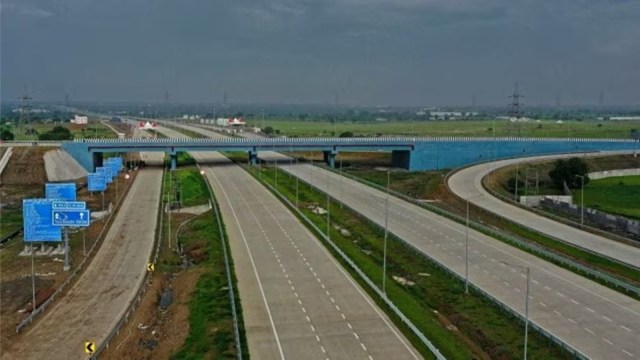Samruddhi Mahamarg: Length, facilities, travel time, speed limit, toll tax and all you need to know
The Samruddhi Mahamarg route, which is also known as the Mumbai Nagpur Expressway, runs through 392 villages, across 10 districts of Maharashtra
 The Samruddhi Mahamarg that links Nagpur to Mumbai. (Express File Photo)
The Samruddhi Mahamarg that links Nagpur to Mumbai. (Express File Photo)Samruddhi Mahamarg, which is officially named Hindu Hrudaysamrat Balasaheb Thackeray Maharashtra Samruddhi Mahamarg after the late Sena founder, is spanned across the state of Maharashtra. This ambitious project aims to revolutionize transportation, bolster economic growth, and elevate connectivity to unprecedented levels.
Here is all you need to know about the Samruddhi Mahamarg:
Where is Samruddhi Mahamarg situated?
The Samruddhi Mahamarg, spanning 701 km linking Nagpur to Mumbai, of which 600-km expressway from Nagpur to Bharvir, in Igatpuri, is currently open to traffic. An MSRDC official confirmed that the remaining 101 kilometers are expected to be open in 2024.
The route, which is also known as the Mumbai Nagpur Expressway, runs through 392 villages, across 10 districts (Nagpur-Wardha-Amravati-Washim-Buldhana-Jalna-Aurangabad-Nashik-Ahmednagar-Thane) and reduces the traveling time to seven to eight hours between Mumbai and Nagpur. The Expressway also connects an additional 14 Maharashtra districts namely Chandrapur, Bhandara, Gondia, Gadchiroli, Yavatmal, Akola, Hingoli, Parbhani, Nanded, Beed, Dhule, Jalgaon, Palghar and Raigad.
Most importantly, it also enhances connectivity to Maharashtra’s major tourist destinations including Shirdi (5 km), Bibi ka Maqbara (5km), Sula Vineyards (8 km), Trimbakeshwar Shiv Temple (14 km), Tansa Wildlife Sanctuary (60 km), Pench National Park (95 km) and Tadoba Andhari Tiger Reserve (124 km).
When was Samruddhi Mahamarg inaugurated?
This stretch was inaugurated into two phases. The 520 km stretch between Nagpur and Shirdi was inaugurated by PM Narendra Modi in December 2022, and the one between Shirdi and Bharvir was inaugurated in May 2023 by CM Eknath Shinde. Additionally, MSRDC is widening the Mumbai-Nashik highway (NH 3) between Vadpe and Majiwada in Thane to eight lanes, with an aim to streamline traffic flow, especially from warehouses in Bhiwandi.
Once fully operational, Samruddhi Mahamarg is anticipated to halve the travel time between Nagpur and Mumbai to eight hours from the current 16.
When will the Samruddhi Mahamarg route between Bharvir and Igatpuri open?
The 25-km long stretch between Bharvir and Igatpuri under Samruddhi Mahamarg route will open in February 2024. The only remaining task in this stretch is the installation of girders for the vehicular over bridge (VOB). After construction of this and the opening of the stretch, the Nagpur portion of the Samruddhi Mahamarg will be completed.
Then only the 76 km stretch till Amane, Thane will remain. MSRDC looks at opening the remaining this pending part by July 2024 and with this the entire Samruddhi Mahamarg will be operational.
What is the speed limit on Samruddhi Mahamarg?
The Samruddhi Mahamarg route is designed for speeds of up to 120 km per hour on flat and non-hilly terrain and 100 km per hour on hilly areas. This speed limit is for vehicles with eight passenger seats. For vehicles with passenger seats of more than eight, the capped speed limit is 100 km per hour on flat and non-hilly terrain and 80 km per hour on hilly areas. All heavy vehicles have to maintain speed of 80km per hour on all terrains.
How much does toll tax cost on Samruddhi Mahamarg ?
Here is the Toll Tax detail for Samruddhi Mahamarg:
| Type of vehicle | Samruddhi Mahamarg toll charges per km | One way toll charges between Mumbai Nagpur Expressway |
| Light Motor Vehicle (Car, Jeep) | Rs 1.73 | Rs 1,212 |
| Light Motor Commercial Vehicle (Light goods vehicle, mini bus) | Rs 2.79 | Rs 1,955 |
| Heavy Vehicle (two axle like Bus, truck) | Rs 5.85 | Rs 4,100 |
| Heavy commercial vehicles (three axle vehicles) | Rs 6.38 | Rs 4,472 |
| Heavy construction machinery | Rs 9.18 | Rs 6,435 |
| Oversized vehicles (multi axle- seven or more axle) | Rs 11.17 | Rs 7,830 |
What are the key features of Samruddhi Mahamarg?
- The Samruddhi Mahamarg Expressway boasts a total width of 120 meters, featuring 6 lanes to accommodate high-volume traffic efficiently.
- Designed with a proposed vehicle speed limit of 150 km/hr, the expressway prioritizes swift and safe travel for commuters.
- The project includes the development of 18 agriculture-oriented new townships strategically positioned at key intersections along the route.
- It distinguishes itself as the country’s most extensive ‘Greenfield’ route alignment, with plans to plant over 11 lakh trees on both sides of the expressway, emphasizing environmental sustainability.
- Incorporating advanced technology, the expressway integrates an intelligent highway management system equipped with CCTV cameras and free telephone booths every 5 kilometers for prompt reporting of emergencies.
- The expressway’s infrastructure comprises an array of structures, including 65 flyovers, 33 major bridges, 274 minor bridges, 8 railway overbridges, 25 interchanges, 6 tunnels, 189 underpasses, 110 underpasses for light vehicles, 209 underpasses for animals and pedestrians, and 8 underpasses and overpasses for wildlife movement, ensuring seamless connectivity and safety.
- With an eye towards sustainability, the project incorporates electric vehicle charging points at strategic locations and plans for solar plants generating 47 MW of energy, aiming to establish the Samruddhi Corridor as a model of energy efficiency.
- Provisions for optical fiber connectivity, natural gas pipelines, and an electricity grid will be laid along the expressway, facilitating digital readiness and resource availability, particularly in industrial townships along the route.
- 01
- 02
- 03
- 04
- 05































